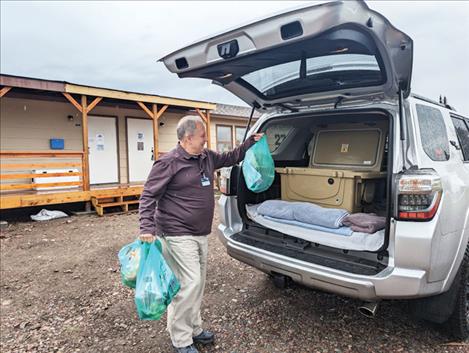Montana State receives $2.3M to bolster mental health support workforce
SU’s Montana Office of Rural Health & Area Health Education Center is administering a grant to train 108 behavioral health paraprofessionals over four years
Hey savvy news reader! Thanks for choosing local.
You are now reading
1 of 3 free articles.
News from Isabel Hicks, MSU News Service
BOZEMAN - Montana State University is helping facilitate a grant to bolster the state’s mental health professional workforce and support people struggling with substance use in rural areas.
The federal Health Resources and Services Administration awarded the $2.39 million grant to MSU and the Montana Office for Rural Health and Area Education Center, or MORH/AHEC, in 2024.
The four-year grant builds on the Montana Family Support Program, which has operated since 2020 and has trained 140 Montanans as behavioral health paraprofessionals through more than 100 hours of instruction.
The new funding aims to train an additional 108 paraprofessionals by 2028 - helping increase mental health support in rural communities that often lack accessible health care options and providers.
The training programs, both online and in person, are mainly housed in MORH/AHEC, which is part of the MSU Mark and Robyn Jones College of Nursing.
While aimed at individuals of any educational background looking to volunteer or enter the behavioral health field, MSU students and graduates have also participated in the trainings. The program reflects the nursing college’s commitment to support and bolster the health of Montanans statewide, said Dean Sarah Shannon.
“This project directly reflects our mission as a land-grant university, showcasing to current and future students that MSU is a resource supporting the health of Montanans, everywhere from on campus to the most rural corners of our state,” Shannon said.
The grant organizers hope to train 27 paraprofessionals each year: 11 community health workers, three community paramedics, five behavioral health technicians and – new this round – eight recovery doulas.
Ultimately, the trainings are geared toward helping youth and families who have experienced trauma, including opioid and substance use disorders, said Natalee Wheeler, the behavioral health project and training coordinator at MORH/AHEC.
Each core training area requires additional development training to build specific skills, including administering naloxone, a medicine that reverses opioid overdose; navigating the child welfare system; and managing aggressive behaviors. There is also an optional apprenticeship element for participants seeking further education.
The bulk of the grant money covers participants’ registration fees and provides a stipend. It costs about $10,000 for each participant, which includes around 100 hours of training, according to Wheeler.
The grant is also funding a new program to train doulas in rural areas to support pregnant and parenting women who have a history of substance use or mental health issues, in partnership with One Health, a Community Health Center consortium. The first cohort started in October 2024 and is the first in the nation so far. Other states have been contacting the organizers to learn more about the program so they can implement it elsewhere, said Beth Carter, program coordinator at MORH/AHEC.
In addition to building the workforce, one goal of the program is to increase awareness of the role of paraprofessionals, said Kailyn Mock, director of MORH/AHEC.
The people enrolled in the program come from a range of backgrounds but often do not have a medical or health-related degree. The trainings provide a pathway for them to enter the field and give back to their communities, Mock said. Once trained, they may be assigned to a patient care team in a clinic or work for a nonprofit, for example.
“They could be a patient navigator, an outreach worker, a case manager. There’s a lot of different titles, but basically, they are doing liaison work between the clinic and the patient,” Wheeler added.
Participants can also take multiple trainings to build their skills, Carter said. For example, someone who is supporting a patient recovering from a substance use disorder may also rely on skills from a suicide prevention training to spot any warning signs. Often, these are the community members who are doing home visits, checking to make sure people are getting groceries and have transportation to medical appointments, for example.
“They’re advocates. They’re helping people find resources,” Carter said. “They’re just kind of that link, oftentimes, to those people within the community that fall through the cracks.”
Additionally, because of the stigma surrounding mental health treatment, people may be more willing to first meet with a behavioral health paraprofessional than a therapist, Wheeler said. The paraprofessional can then help connect the individual with other resources and create a treatment plan.
Paraprofessionals can also help reach at-risk populations that are harder to connect with, like teenagers. For example, one participant used the online trainings to better support her teenage sons, as well as other adolescents she mentors through her volunteer work at a church in her rural community of Ronan. She’s now gained the confidence to continue her education and is comfortable with remote learning.
“She told me, ‘I’ve always wanted to go to school for social work, but it’s a huge financial barrier. But this program seems like a good fit for me to get continuing education and move into a behavioral health role,’” Wheeler said.
That example illustrates the goal of the program: to dually benefit people by training them to help their communities and improve themselves professionally.
The organizers said that so far, it’s clear the work is making a difference.
“I think the momentum and understanding of these roles is far greater than five years ago. We’ve definitely made a lot of headway there,” Carter said. “There’s more to be done, but I think that communities are seeing the return on investment – not just in dollars but in the actual impact they are making.”
















